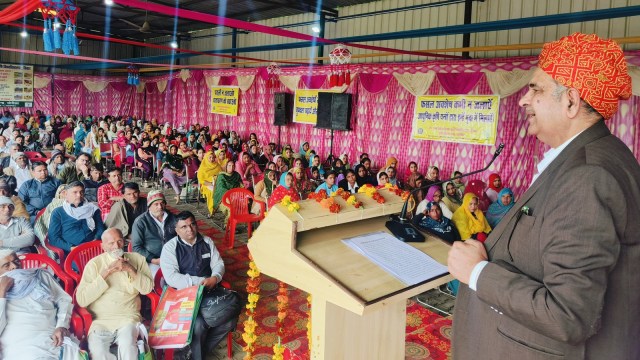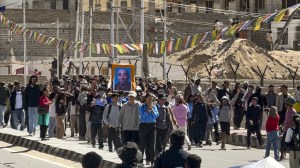A day at Kisan Mela | ‘Essential nutrients get destroyed’: Experts warn farmers of perils of crop residue burning
Drawing a parallel that there would be no shortage if the same quantity of dug-out water is recharged, Kamboj said that even the farm residue should be treated likewise.
 Dr B R Kamboj, Vice Chancellor (VC), Chaudhary Charan Singh Haryana Agricultural University, during his address. (Express Photo)
Dr B R Kamboj, Vice Chancellor (VC), Chaudhary Charan Singh Haryana Agricultural University, during his address. (Express Photo)A super seeder, straw baler, and shrub master — neatly placed in a section — kept farmers engaged at Krishi Vigyan Kendra’s (KVK) kisan mela, Halalpur village in Sonipat. Despite the occasional light drizzle on Thursday, nearly 200-300 farmers took part in the Chaudhary Charan Singh Haryana Agricultural University (CCSHAU) event, themed ‘Management of Stubble’.
Speaking to The Indian Express, Agricultural Engineering Scientist Dr Sundeep Antil said that balers are helpful in ex-situ management (handling stubble outside the field) of paddy straw. Baler straw is collected in the form of bales and taken out from the field.
“Through the use of super seeder, the paddy residue can be incorporated in soil, which is called in-situ management (handling stubble inside the field) of crop residue. The super seeder can manage residue and sow wheat crop in a tillage operation, while with other ordinary farm machinery, five to six tillage operations are required for in-situ paddy residue management and sowing of wheat crop. Hence, super seeders can protect soil health by reducing tillages, and saving time, fuel, fatigue of farmers and money,” Antil said.
Banners reading “paraali na jalao, paryawaran ko bachao” and “fasal awshesh kabhi na jalayein, aadhunik krishi yantra dwara inhe mrida main milayein” were among the other messages put up to educate farmers about the perils of crop residue burning.
 A super seeder and shrub master displayed at Kisan Mela in Sonipat. (Express Photo)
A super seeder and shrub master displayed at Kisan Mela in Sonipat. (Express Photo)
Dr Kuldeep Dahiya, scientist at Sonipat KVK, said farmers burn stubble during the summer months of April and May too, but the pollutants get dispersed due to the weather.
Addressing the farmers, Dahiya said: “Paddy stubble burning impacts environment more, because of low temperatures in colder months. Particulate matter, which adversely affects health, increases by four to five times in this season.”
“During stubble burning, harmful gases like carbon dioxide, carbon monoxide, nitrous oxide, and sulphur dioxide among others enter our system via breathing. This is dangerous to the elderly and children, exposing them to various diseases… Also during stubble burning, essential nutrients like nitrogen (80-90 per cent), potash (21 per cent), phosphorus (25 per cent) and sulphur (6-7 per cent) in our soil get destroyed. Stubble also works like manure,” Dahiya added.
Suggesting that farmers should bury crop residue inside the field if they have time before the next harvest, Dahiya said: “And if you don’t have time, then spread the tiny pieces of it.”
 Farmers present during Dr B R Kamboj’s address. (Express Photo)
Farmers present during Dr B R Kamboj’s address. (Express Photo)
Highlighting that the mela recorded a significant presence of women from all age groups, chief guest Dr B R Kamboj, vice chancellor of CCSHAU, Hisar, said: “Today over 50 per cent of our daughters study Agriculture. There was an earlier perception that veterinary is a male-dominated profession, but now, women are also doing well in the field.”
Drawing a parallel that there would be no shortage if the same quantity of dug-out water is recharged, Kamboj said that even the farm residue should be treated likewise. “We believe that a ground’s strength should remain intact. We should return around 100 quintals of organic stuff to the ground, and 50 quintals of this can be fulfilled from stubble itself. This will help in balance maintenance for future generations.”
Kamboj further said that when we keep stubble in the ground, it removes the flow of excess water during heavy rainfall or floods — the excess water goes to the ground, preventing flooding. “And in cases of no rainfall, stubble retention does not let water inside the soil evaporate, keeping it moist,” Kamboj said. “When our children get even a little burnt, we apply ointment. It is similar when fields get burnt… stubble has all the necessary 17 nutrients that the soil needs, that you otherwise buy from outside. We need to understand this.”







